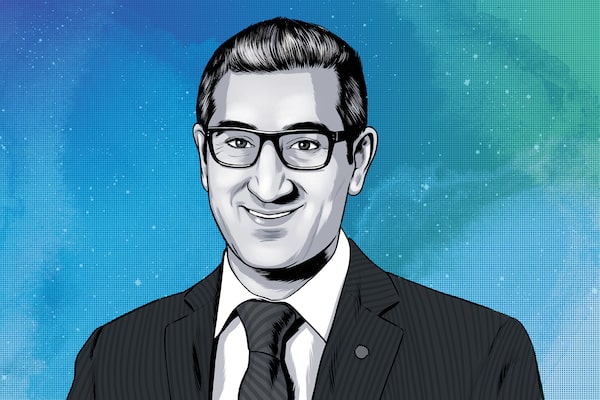
illustration of Sadiq Adatia.Illustration by Illustration by Joel Kimmel
Money manager Sadiq Adatia sees the recent market swings as a perfect opportunity for investors to revisit their risk tolerance.
“If it was too stressful for you, your risk tolerance probably should come down. If you were fine, then you’re probably invested the right way,” says the chief investment officer at BMO Global Asset Management, which oversees about $165-billion in assets, of which he directly manages about $58-billion.
The past couple of years has also been a lesson in diversification for long-term investors. Mr. Adatia points to technology stocks, which surged after pandemic lockdowns forced people online. More recently, rising inflation and Russia’s invasion of Ukraine sent commodity prices soaring.
“Going forward, the emphasis will be back on stocks that benefit from the reopening,” he adds.
Then there’s the geographic diversification: “With geographies, the U.S. has done exceptionally well, but now Canada has come to life,” he says. “So you want to have a blended portfolio that helps mitigate the volatility and can add value over the long term, versus just sitting in cash.”
He points to the steady returns of one diversified fund he oversees – the BMO Balanced ETF Portfolio (Class F) – which has risen 4.5 per cent over the past year, as of March 24. The fund’s average annual compounded growth rate was 13.8 per cent over the past two years and 6 per cent over the past five years.
Stocks with a sustainable focus appeal to this portfolio manager
Why this money manager is buying tech stocks again
The Globe and Mail recently spoke with Mr. Adatia about what sectors he’s been buying and selling, and a stock he wishes he bought back when people started reading books online.
Describe your investing style
Our style is always about looking at risk versus your reward. We look at opportunities in the marketplace – wherever they may be – and if the risk-reward dynamics are favourable, we’ll be adding to our risk; if they’re not we’ll be taking it away. An example is the 2020 environment when the markets had declined tremendously because of the pandemic and no one wanted to own any equity assets. Risk was cheap. It was the best time to own equities. We still have a tilt toward equities today, but that’s because the alternative, fixed income, is very expensive in a rising rate environment.
When it comes to sectors, we try to look out for the next few years and what the trends are. Canada is a good example right now because of commodities but it also has strong financial companies. Also, the consumer in Canada is stronger.
What have you been buying or adding to lately?
Energy has been our biggest play, going back to September, well before the Russian invasion of Ukraine. We added to positions as part of the economic reopening from the pandemic. We think energy has a lot of upside, even from where it stands today. There are also opportunities for increasing dividends. Another plus is that energy does well in a rising rate environment.
Financials is another area we like. The companies have good balance sheets and are increasing dividends. Consumers are in good shape and the appetite for loans and mortgages is strong. One worry is the flattening of the yield curve [which happens when investors expect near-term interest rate hikes and are less confident on the economic growth outlook]. We have been taking some profits in the sector as a result.
A more speculative area we are looking at is the travel and tourism industry, in particular airlines. Although they have a lot of debt and energy prices have gone up, which are negatives, I think they will see massive demand coming through in the near term and consistent demand going forward – and they will have pricing power. It’s a good opportunity to play the reopening and rising consumer demand.
What have you been selling or trimming?
We recently trimmed our international exposure across the board, which largely includes exposure to Europe. We don’t know how long the Russia-Ukraine conflict will play out, but the longer it does the more detrimental it is to Europe. So we want to be underweight international markets as a result. We’re also selling a bit of our U.S. positions, going from overweight to more neutral in our portfolios. Technology has had a good bounce lately, but rates are going up and will put pressure on some of those growth companies south of the border. We’re also taking some profits in emerging markets, in particular China, which has benefited from some of the sanctions that have been put on Russia.
What’s a stock you wish you bought, personally?
Amazon.com AMZN-Q when it started selling e-readers about 15 years ago. My wife is an avid reader, and when I pointed out this company she said nobody would want to read books online – that they prefer the physical hardcover version. I thought that made sense so we didn’t buy it. I like to joke with my kids that their future would’ve been significantly better if we had.
This interview has been edited and condensed.
Be smart with your money. Get the latest investing insights delivered right to your inbox three times a week, with the Globe Investor newsletter. Sign up today.